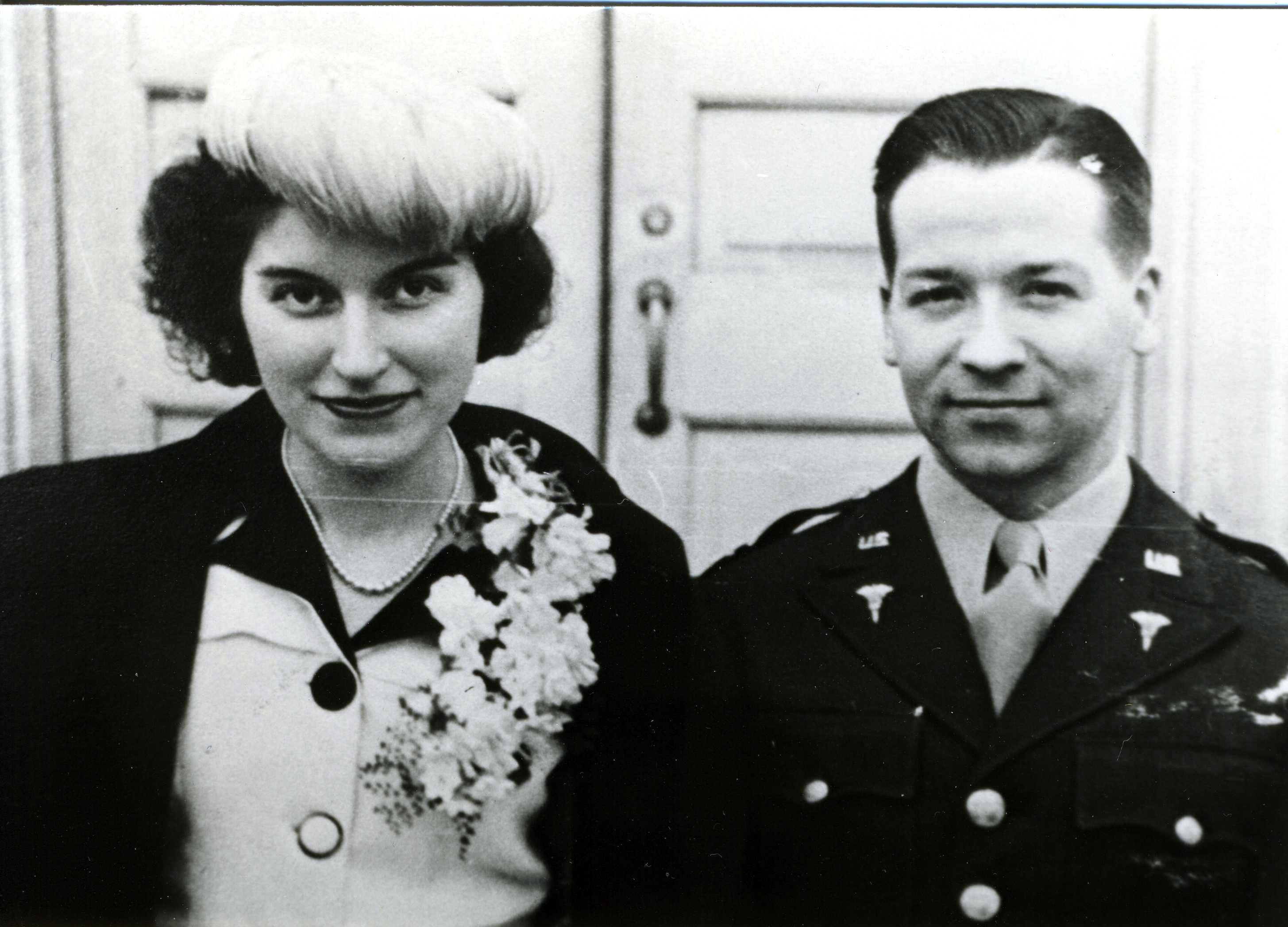 |
| Fort Bragg, NC, January 7, 1943 |
 |
| Fort Bragg, NC, January 7, 1943 |
Probably during Thanksgiving vacation
in 1938, Francis first met Eileen. She was a classmate of Francis’s
sister Lucille at Borgess School of Nursing in Kalamazoo. Nursing
students had little time off. Eileen would first come home with
Lucille as the Cork street farm became her home-away-from-home.
Later, she’d come by herself, taking a bus to the end of Cork
street where she would be picked up by Emma or Martin. (Eileen was
from Flint; and Indian Trails bus line and her brother Russell were
her transportation). Eileen was from a poor family as her father had
died. [We will add more about the Labranche history in another section.]
Emma and Eileen bonded like mother and
daughter.
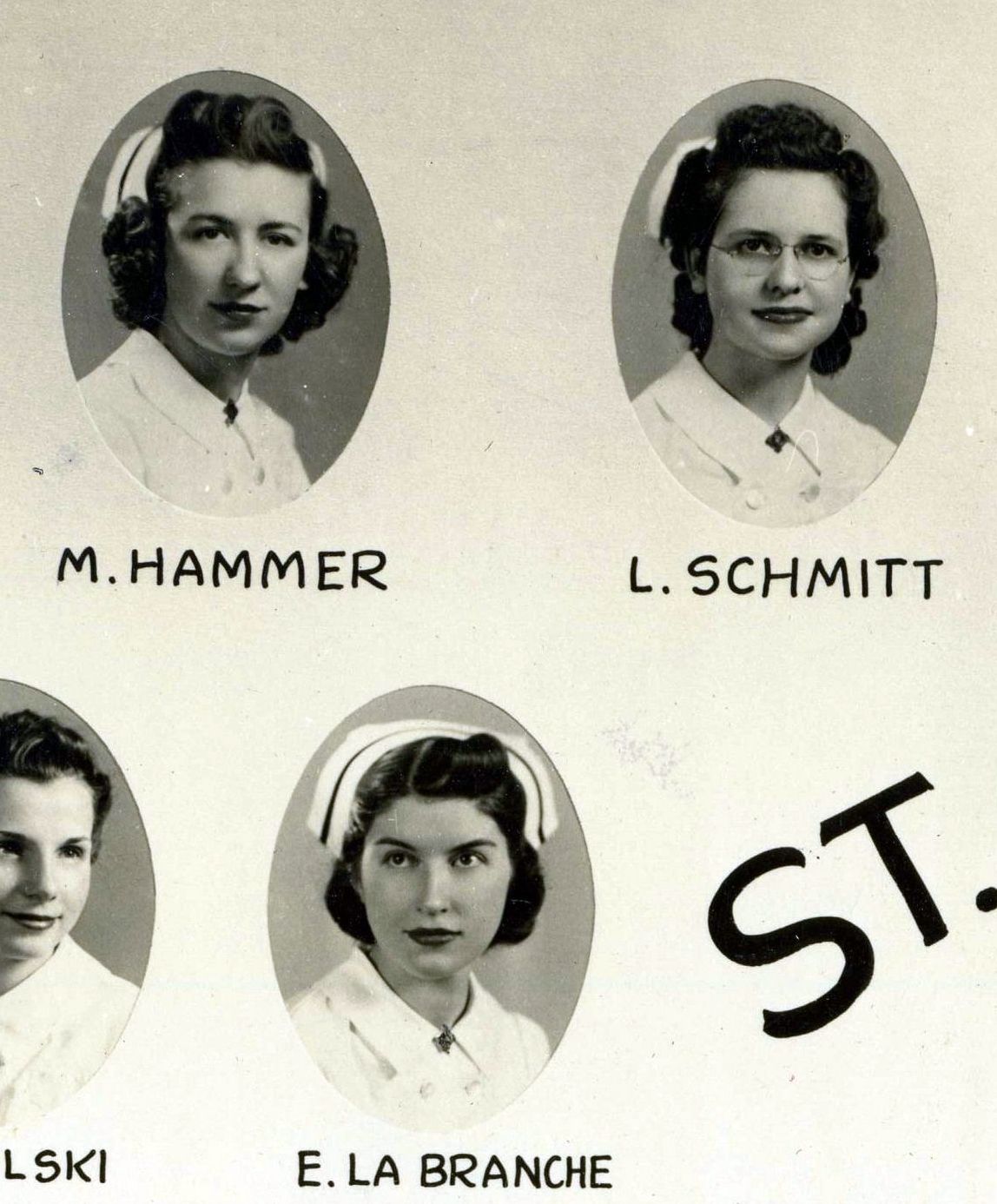 |
| Eileen
graduated with Francis's sister, Lucille, and both were close with
Marge Hammer, the brother of Dick Hammer who became a longtime neighbor
on Brown Street after moving his law practice to Garden City and
officing at Francis's Dental office for a few years. |
Francis feels Eileen was not greatly
impressed by him at first meeting. [Eileen confirmed this with Dick in 1967 when discussing Francis's feelings that Dick was getting married too young at age 22.] Francis returned to Milwaukee;
when he came home on vacation, he would often see Eileen and continue
their friendship.
During dental school, war clouds loomed. Despite a Pacifist’s congress’s reluctance, the Roosevelt administration was starting to build up the armed forces in preparation for WWII. This included medical personnel. Francis first ventured with a friend to investigate the Navy at Great Lakes Naval base. However, he failed the minimum height requirement (5’6” by a half inch). At least four of Francis’s classmates joined the Navy; many of the rest of his graduating class of 25 eventually joined the army Dental Corps, including one who was killed in Italy.
The army proposed a commission if the
dentist would accept one year active duty in the United States Army
Reserve (USAR). Francis accepted and was sent to Fort Bragg, NC. In
September 1940. During that year, the worsening situation created
pressure to volunteer for an additional year which Francis did. The
US entered the war during the second year with the Pearl Harbor
attack on December 7, 1941.
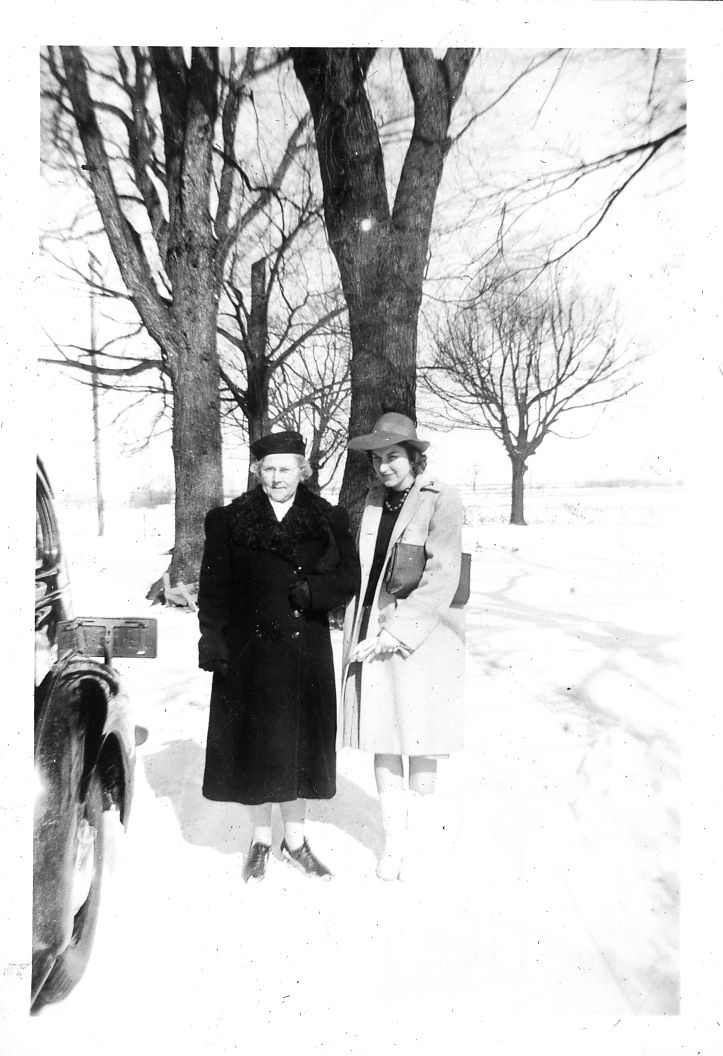 |
| Emma and Eileen outside the Cork Street farmhouse in 1942 |
In 1941, Lucille and Eileen graduated from Borgess School of Nursing. (Eileen had both a bachelors and a nursing degree after 5 years in college – she started young and after four years was too young to take the state board exam). Francis returned to Kalamazoo for the graduation with a diamond ring. Eileen accepted his proposal. Implied was that Francis wouldn’t get married until after the war. Eileen continued to work as a nurse in Flint but visited Francis at Fort Bragg in 1942 and met Dr. Paul and Helen Campbell, with whom she stayed.
The highlights of the Fort Bragg years were Francis and Eileen’s marriage in The Post Chapel on January 7, 1943, and Tom’s birth on November 13, 1943.
Eileen returned to Flint, working as a
nurse in Woman’s Hospital. In 1942 she visited Francis at Fort
Bragg. Francis and Eileen were married in the post chapel, January
7, 1943. Eileen carried her wedding hat in a hat box on the train;
but here suitcase containing the wedding dress arrived separately.
Francis and Eileen would check each subsequent train looking for her
suitcase. The wedding date of January 6 (Little Christmas) came and
went. Finally they went to a department store and got another dress
and got married on January 7. Afterwards, they went to the train
station where Eileen’s suitcase finally arrived. Then they drove
across Fort Bragg (about 25 miles due west) to Southern Pines Inn
where they spent seven days. (At the time of this writing, Francis still had a butcher knife
bought during a shopping excursion). [He liked to keep things.]
When the couple returned to Fort Bragg, they were able to get married officer quarters at a two-bedroom duplex at 12 Hull Road in Fayetteville, NC, about eight miles away. Fortunately, Francis had a car, a 1935 black Desoto 4 door sedan, purchased for $525 in 1941 during a trip to Kalamazoo through the intercession of his mentor, the dentist Morrison M Heath. However, gas was rationed to a few gallons a week – but enough to get to and from the base. Since the married quarters were temporary buildings in clusters, car pooling was also used. The couple lived there until May of 1944 when Francis was ordered overseas and Eileen returned to Flint with her new baby, Tom.
Officers’ wives were not permitted to work; but Eileen was happy to be there and enjoyed being a young mother. A lot of children were born during Francis and Eileen’s Fort Bragg years to their friends, as well.
After Francis left for Europe, the
quartermaster’s corps came and crated all of the family’s
belongings (including an unemptied wastebasket) and shipped to a
little apartment above Alf and Amanda Gatschene’s flat in Flint. [Amanda was Eileen's mother and Alf was her second husband.]
Tom came a month early, on November 13, 1943. Fortunately the army hospital had competent OBs. Francis had Officer-of-the-Day duty that night and was supposed to be informed by the OB, Dr. Grimes, if Eileen was to deliver. Francis never heard and so didn’t find out until the next morning although he was in the hospital all night. This set a trend—Francis was not at any of his twelve children’s birth.
During his 3 ½ years at Fort Bragg, Francis served in the Station Complement, the fixed personnel on the post whose job was to get enlistees (and eventually draftees) into fighting readiness in 18 weeks. This included both military training and medical/dental corrections as needed.
Soldiers would be assessed dentally into four categories with the highest requiring extractions. To chew military rations required 3 pairs of opposing teeth. Those who lacked that minimum would get dentures or other prostheses. (Lots of soldiers fell into this group as some soldiers had never had any dental treatment in their lives). About 180 dentists worked at Fort Bragg (including training units) under the dental chief-of-staff, Col. Thomas Davis.
When soldiers left the fort, the goal was that they not have any dental emergencies during combat. Francis learned to do good dental amalgams during this training. His primary classification was as an oral surgeon (Military Occupation Specialty (MOS)). In this role, he would extract teeth, as many as a hundred a day. (The CO would be unhappy if dentists extracted less). Those who restored teeth also had unofficial quotas as to how many fillings were done per day. Monthly reports tracked this work.
The experience taught Francis the goals of preventative and good restorative dentistry where as many teeth are preserved as feasible.
The five war years gave Francis a good
internship and allowed him to work with dentists from around the
country. He learned the most from two young Raleigh dentists (close
enough to go home on weekends). They taught him the satisfaction of
treating each patient as an individual as if they were in private
practice.
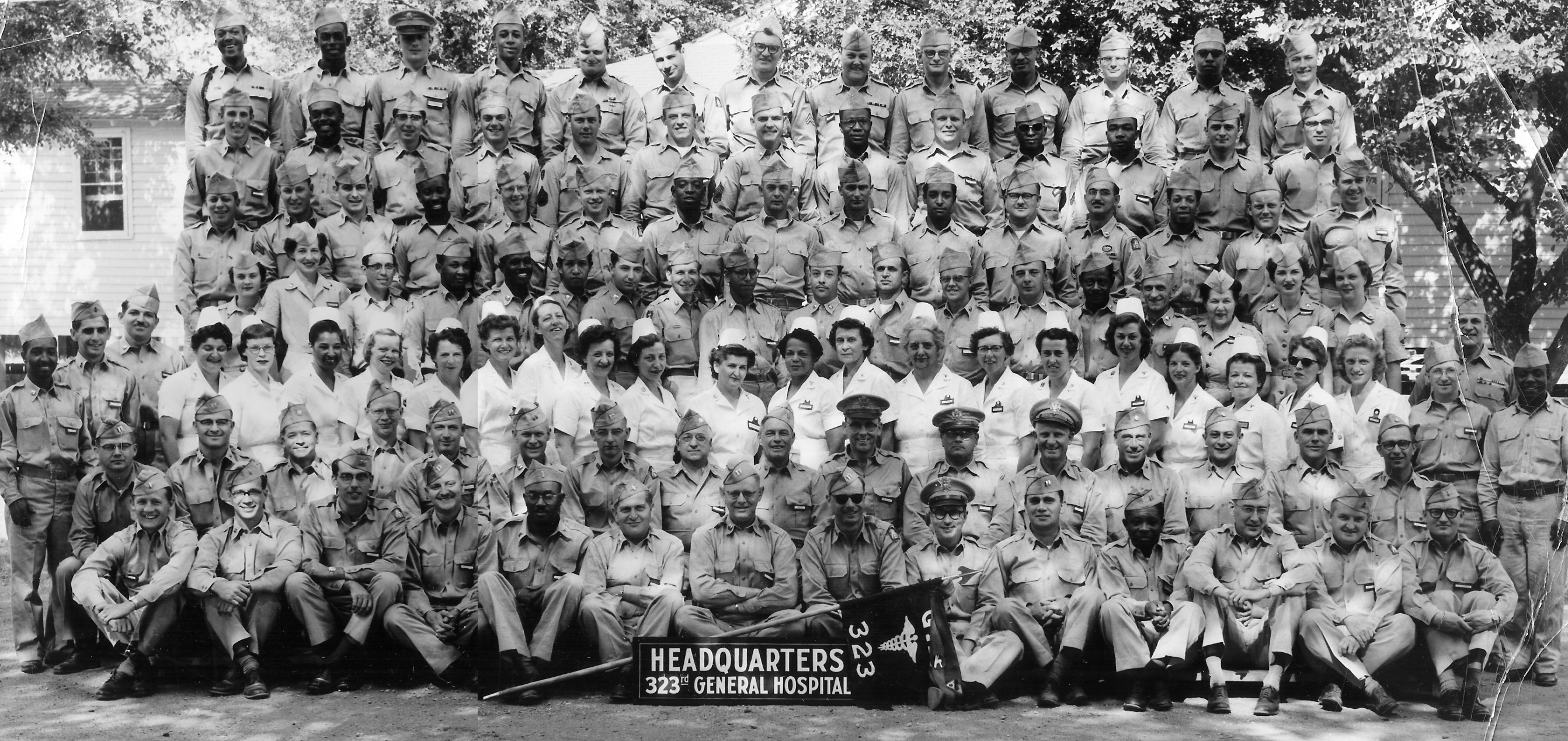 |
| Can you find Francis in this picture? If so, let the rest of us know. (Study a larger copy by clicking here.) |
In May 1944, Francis was assigned to the 114th US Army General Hospital (a 1000 bed hospital formed at Fort Bragg which could be expanded to 2000 if required). People were sent from around the country. The complement included 90 officers (with 5 dentists), 150 nurses, and 500 enlisted personnel. In June 1944, The hospital unit traveled by private train to Fort Dix, N.J. where they boarded the USS Argentina. The Argentina joined a week-long convoy crossing the Atlantic to Glasgow, Scotland.
Being limited by the slowest boat, convoys were sitting ducks but were protected by destroyer escorts bobbing on the horizon. The convoy experienced submarine alerts, the most piercing sound known at that time, but managed to reach Scotland without losing any of the ships.
The officers stayed in cramped quarters, nine would stay in triple-tier bunk beds in a stateroom used by one couple during peacetime. They each were allowed one duffle bag. The convoy operated under blackout conditions.
After Francis left Fort Bragg, the quartermaster corps packed up their furniture and Eileen and Tom returned to Flint by train. The furniture arrived weeks later to furnish a small apartment above Eileen’s mother (Amanda) and step-father (Alf Gatschene).
After arriving in Glasgow, Scotland, the unit took a train to their assigned address near Kidderminster, England, where they set up on a prepared hospital site and never moved after that. The 114th was part of the Malvern Hospital Centre, one of 15 specialty hospitals that fanned out like spokes on the wheel from Malvern. The 114th was designated as an orthopedic hospital for long bone fractures. These became targets for German bombing.
Francis had a good friend, George Rosenberg, M.D. from Abbeyville, S.C. who loved the orthopedic wards and became an orthopedic surgeon when he returned to civilian life.
Francis stayed there until the end of the war, treating causalities from the front lines of Northern Europe, and returning them to active duty as soon as possible. If the projected healing time was long, the patient would be returned to the US. During the Battle of the Bulge, the 114th had wards of soldiers with trench foot (an injury from the cold; soldiers wouldn’t take their boots off for days on end and didn’t have changes of clothing). Feet could be swollen to twice their size). The 114th also had wards of Neuro-psychiatric (NP) patients (called “shell shocked” in WWI). These were soldiers who had more battle stress than they could stand. They’d be sedated in dark wards.
The attitude of any soldier from the
front lines was NOT to be rehabilitated enough to return to the front
lines.
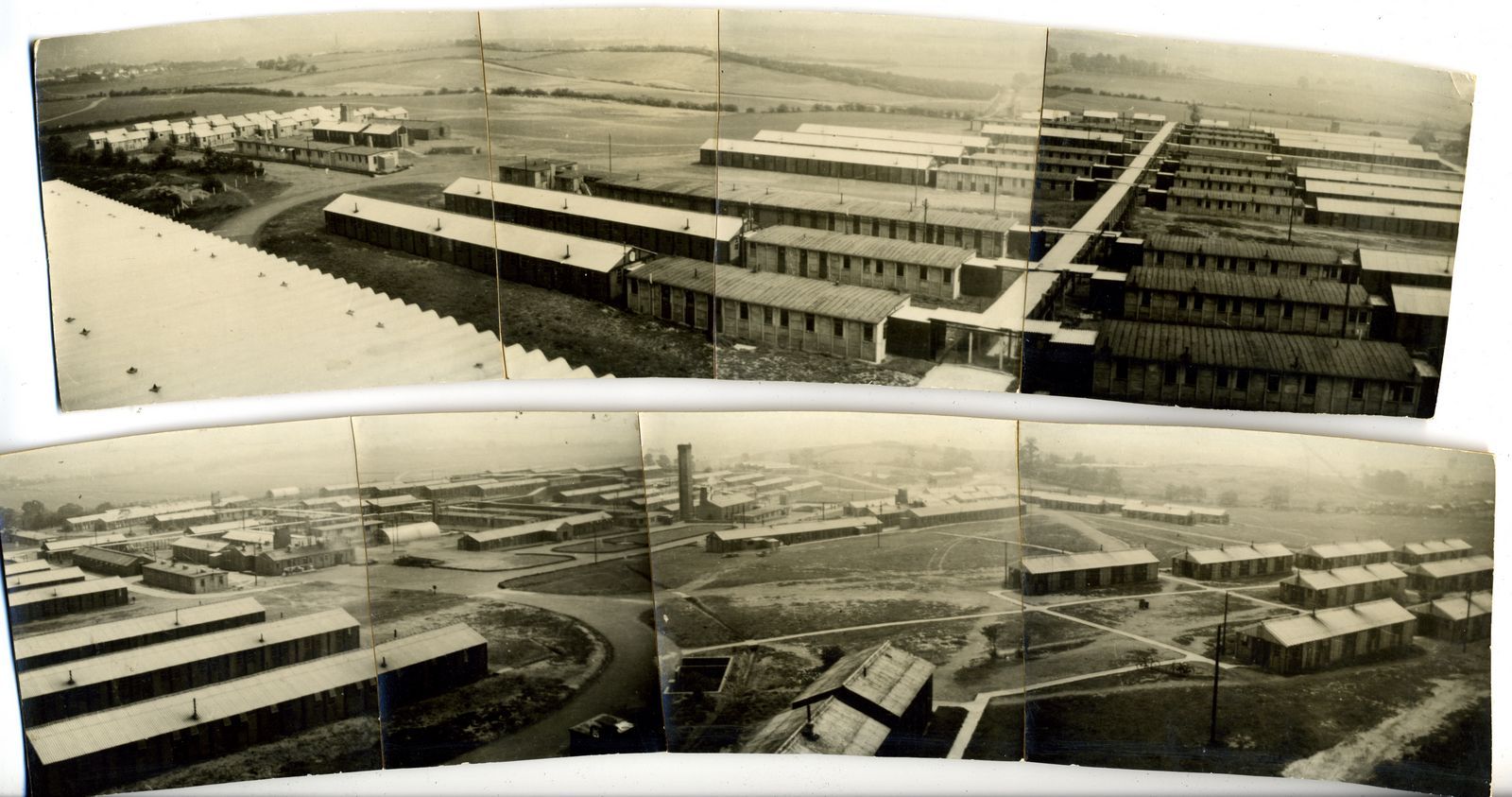 |
| Per Tom: Here is a
stitched-together panoramic photo which Francis prepared with his
friend Dr. George V Rosenberg. The bottom series is meant to
attach to the right side of the top series. The wards are the
huge central section of temporary buildings connected by covered
walkways. Nurses quarters are the cluster of buildings on the far
left. Officers huts are at the end of the walkway, in the rear of
the top photo series. Enlisted quarters are at the far
right. Surgery was performed in the buildings to the right of the
wards, in the rear of the lower photo series. These photos were
taken from the roof of the officers club. According to a local
historian, this site was known as Camp Bewdley,
built to house American troops before the Normandy invasion.
After D-Day, the camp was converted to a hospital. Today, the
buildings are gone and the site is a nature reserve. |
The
hospital was temporary construction, mostly masonry. If it had to
expand to 2000 beds (which it didn’t) tents would have been used.
The place was heated by low-quality English coal in stoves. Officers
stayed in one-room “huts” – about 25’ by 25’ with six to a
room in individual beds. Huts would be spread throughout the hospital
grounds. A walk up the hill was required to use the latrine and
shower (with hot water one hour per day). Most of the time,
personnel would use their steel helmet as a washbasin. Not gracious
living, but better than what the G.I.s had in the field.
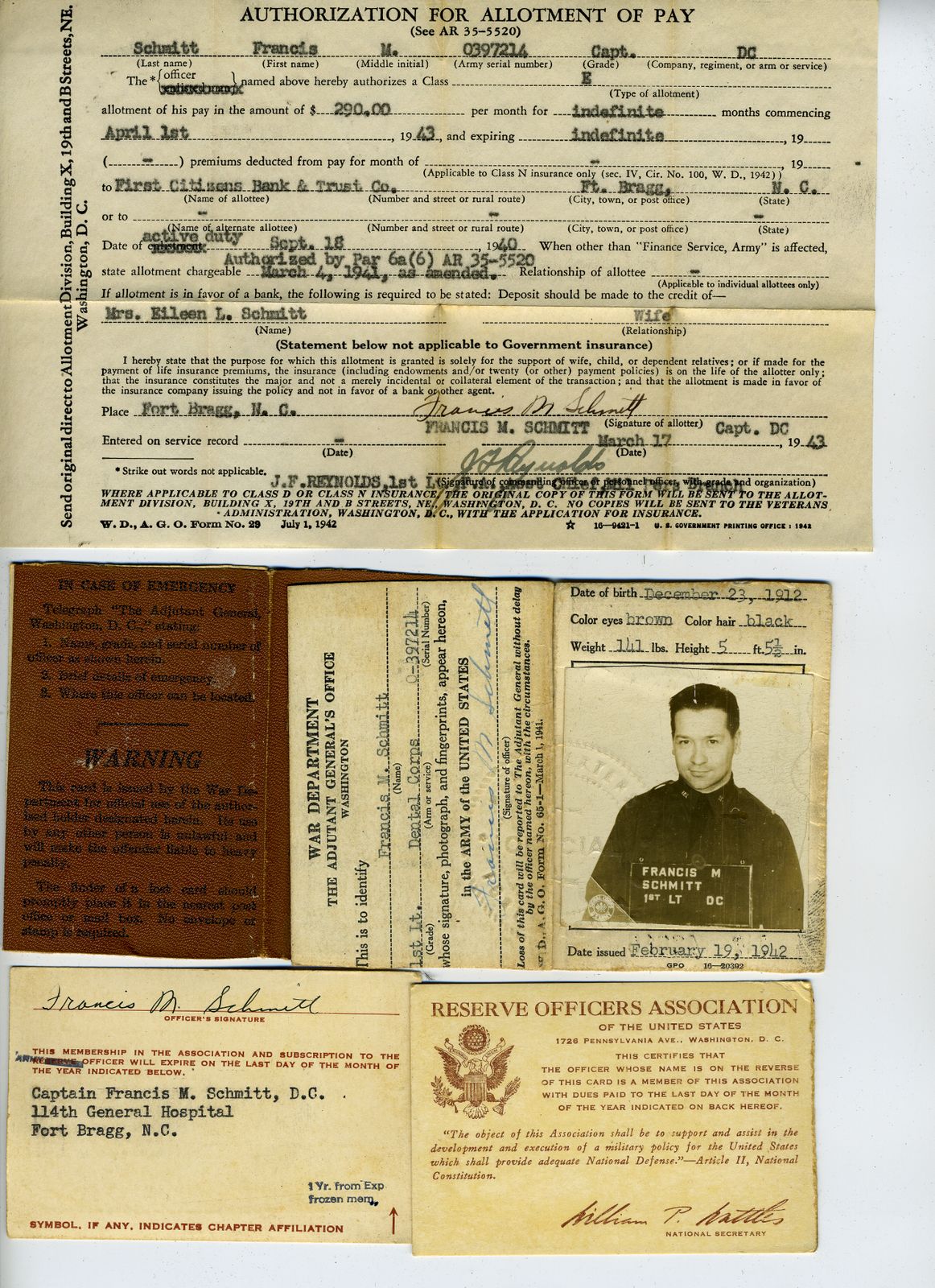 [Francis took many photos of his days in England and kept them in albums which his son, Tom, has put on the web. Click here to view them.] |
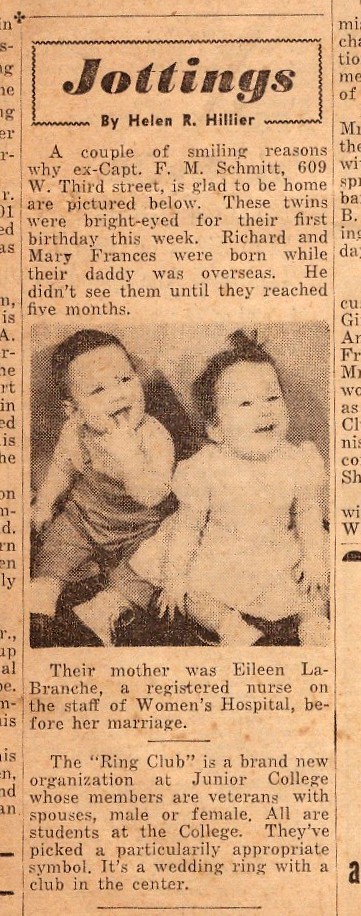 Mary and Dick on their first birthday Mary and Dick on their first birthday |
Shortly after arriving in England, Francis received a letter from Eileen saying that she was pregnant. On March 4, 1945, Dick and Mary arrived in Flint, MI. Francis was informed several days later, probably by telegram which said “Boy arrived at 6PM; girl arrived 6:05.” Francis replied, “keep both.”
After VE day (May 8, 1945), the plan was to redeploy troops to the Pacific. Some European Theater troops were loaded directly aboard ships for transit. Francis was sent to a replacement center in England to be returned to the US for reassignment, probably to a Pacific-bound unit. (Churchill and Roosevelt had agreed that they could not fight a two front war all out; so once the Europe front closed down, troops would be redeployed to the Pacific).
Aside: Germans were glad to be taken
prisoner as the POW experience was better than being in the German
army. Fort Bragg had the first US prison for German POWs. Several
German POW prisons were set up in the US where the Germans had an
opportunity to work. German POW camps would be run under the highest
officer in camp. Francis once treated a young (under 18) German POW;
his POW translator commented when reading Francis’s name on his
operating gown: “Schmitt, you’re in the wrong army!”
[Perhaps there is some irony here as Francis's father, Martin, had to
sign a statement when WWI broke out, that he was not loyal to the
Kaeser. Martin was born in Germany and did not become a US
citizen until later. When she married him, Emma lost her US
citizenship.]
Francis was sent to Indian Town Gap,
PA, where he was immediately given 30 days leave. Francis set out
by bus to Flint to see his newborn twins, arriving in July 1945.
During the 30 day leave, atomic bombs were dropped in Hiroshima and
Nagasaki and VJ Day occurred on August 15. Francis awaited future
orders (which were slow in coming) in Flint. Probably in September,
Francis went to
Indianapolis to be officially demobilized. Since he had 90 days of
unused leave time, his official termination was December 27, 1945.
To see a list of Francis's military assignments, click here.
To see a picture album from Francis's time in England during WWII, click here.
